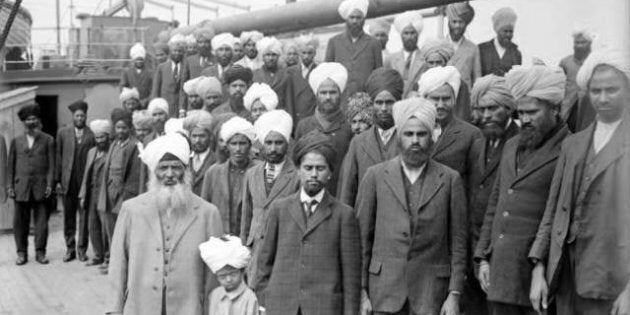
When the Vancouver Canucks played in their alternate Vancouver Millionaires jersey last week, I was torn by the confluence of sports, history, race and the idea of Canada.
That may seem like an extreme response, but it stems from the overt display of one of the icons of hockey in Vancouver, Fred "Cyclone" Taylor. Taylor was the star of the Stanley Cup winning Vancouver Millionaires, one of the league's highest paid hockey player, and a member of the Hockey Hall of Fame.
He also had a summer job that connected him with one of the most iconic historical moments in Canadian history - the arrival of the Komagata Maru.
Pressured by his in-laws to find a respectable job, Taylor parlayed his Ottawa connections into regular work with Canada Immigration. When his hockey career brought him to the West Coast as a star player with the Millionaires, his post in the immigration office was also transferred. But on the eve of World War I, it was Taylor who was one of the first people to greet the steamship when it tried to dock in Canada.
The Komagata Maru incident involved 356 passengers, all British citizens, who were denied entry into Canada. In 1914, the ship arrived in Vancouver where it was denied docking for two months due to policies designed to keep out ethnicities the government deemed "unfit" to enter. Eventually the ship was told to leave the country at gunpoint.
As one of the higher ranking officials in Vancouver, Taylor was in regular contact with the ship and its passengers. He saw first hand the hardship wrought on the passengers as they were forced to live in deteriorating conditions for months, pushed to the brink of starvation.
A CBC Radio documentary from 1964 that marked the 50th anniversary of the Komagata Maru's arrival featured a then-retired Taylor speaking candidly of his experiences:
"The boat arrived here around 5 a.m. The department had detailed its East Indian interpreter at that time and myself to meet the vessel at this very early hour. There was no commotion. The meeting of this boat was no different than any other that had come into the port before or since other than there were quite a number of East Indians in the Inlet on small craft trying to great their brethren from India. And on board, the East Indians were naturally a bit excited at seeing their friends and seeing this new world.
But apart from that it was exactly the same as meeting or greeting any steamer that arrives in Canada. The interpreter accompanied me to the Captain's quarters and Mr. Gurdit Singh who was in charge of the party, accompanied us to the Captain's quarter where we exchanged greetings, picked up the papers, explained to the Captain that his men for the time being - that is the East Indians passengers - would not be allowed to go ashore. And, well, after 20 minutes or half hour conversation we left."
When I first heard this story from Simon Fraser University (SFU) Professor Emeritus Hugh Johnston, I was struck by this unique historical connection. Johnston himself has an engaging storytelling style and wrote the seminal text on the Komagata Maru. As we worked together on a team that created SFU's Komagata Maru website, I heard Cyclone Taylor's story recounted numerous times at events retold by others.
Cyclone Taylor provided non-South Asians an "in" to the story of the incident. Oftentimes I felt that the underlying sentiment was that they didn't see the Komagata Maru as a Canadian story - even though 22 of the passengers were returning Canadian citizens. I heard responses that the Maru story was only important -- and could only be properly understood -- by those of South Asian heritage. I began to question certain responses that it raised.
This lack of acceptance and relegation of the Maru story to the margins of Canadian history does a disservice not only to the diversity of early settler experience, but to the everyday moments of intercultural co-operation that made up their daily lives.
If Vancouver can claim one 100-year-old story as its own, then I'm sure that even without the backing of a multi-million dollar marketing machine, it can have the space for another. The Komagata Maru is not just a story about 1914, it entails issues of racism, discrimination, exclusion and immigration that have direct, real world impacts today.
As a postscript to the Cylcone Taylor story, The Vancouver Sun played an interesting role 13 years after the documentary. In 1976, Giani Kartar Singh, a 92-year-old passenger from the Komagata Maru finally arrived in Vancouver. He recalled his own journey to Hugh Johnston and spoke of the 11 months of hardship he faced during the whole ordeal. The Vancouver Sun organized a meeting between the two "adversaries" and snapped a picture of them shaking hands. The sentiment was a thinly veiled metaphor for burying the hatchet.
I think there's still something to be said for that.